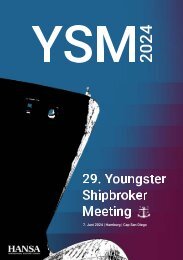HANSA 10-2017
Fährschifffahrt | Brexit | HIPER | Schifffahrt der Zukunft | Börsenbericht | US Ports & Hurricanes | Abwasser | Häfen Niedersachsen | HVAC | Job-Börse | Offshore-Marktkompass
Fährschifffahrt | Brexit | HIPER | Schifffahrt der Zukunft | Börsenbericht | US Ports & Hurricanes | Abwasser | Häfen Niedersachsen | HVAC | Job-Börse | Offshore-Marktkompass
Sie wollen auch ein ePaper? Erhöhen Sie die Reichweite Ihrer Titel.
YUMPU macht aus Druck-PDFs automatisch weboptimierte ePaper, die Google liebt.
Schiffstechnik | Ship Technology<br />
might be able to supply complimentary<br />
technologies including on-board DC<br />
grid, low power DC lighting and power<br />
management systems«, Atkinson tells<br />
<strong>HANSA</strong>.<br />
Commenting on this latest development<br />
he adds: »It’s great that we are able<br />
to co-operate with Hisafuku Kisen and<br />
we very much appreciate their cooperation<br />
in helping us move this important<br />
project towards sea trials.« Chikashi<br />
Yamane, President of Hisafuku Kisen,<br />
stated. »Our company is pleased to be<br />
part of this exciting project which is leading<br />
the way towards the use of renewable<br />
energy related technologies on ships.«<br />
The production of each EnergySail to<br />
be used during the sea trials will be undertaken<br />
at the workshops of Teramoto<br />
Iron Works in Onomichi. This company<br />
was also involved in the production of<br />
rigid sails in the 1980’s and has extensive<br />
experience regarding the manufacturing<br />
of high quality marine fittings for ships.<br />
In the 1980’s several Japanese ships<br />
were fitted with rigid sails with the aim<br />
of reducing fuel consumption. This was<br />
driven largely by the oil crisis in the<br />
1970’s which resulted in oil shortages<br />
and the price of oil soaring. However the<br />
oil crisis passed and when oil prices fell<br />
in the 1980’s the viability of rigid sails in<br />
terms of cost was undermined.<br />
However Japanese ships such as the<br />
»Shin Aitoku Maru« and »Usuki Pioneer«<br />
which were fitted with JAMDA<br />
(Japan Machinery Development Association)<br />
rigid sails, did prove that rigid sails<br />
reduced fuel consumption. More than a<br />
dozen ships were fitted with these JAM-<br />
DA sails.<br />
Today the amount of potential savings<br />
depends on »a few variables such as the<br />
ship type, the route it operates on and<br />
the operating profile of the ship«, Atkinson<br />
explains, adding »however our aim is<br />
to provide a system that can reduce fuel<br />
consumption by around <strong>10</strong>% annually.<br />
Theoretically higher fuel savings can be<br />
achieved through the use of larger sails<br />
(20 m or higher) but our research indicates<br />
that the use of large sails on most<br />
modern powered commercial ships is not<br />
feasible.« 8% could be saved by sails and<br />
2% from solar.<br />
Although the system was initially designed<br />
for large ships, much of the associated<br />
technology might also be suitable<br />
for smaller vessels such as coastal<br />
freighters, passenger ferries and tou rist<br />
boats. A study is also being conduc ted<br />
to determine if it would be feasible to<br />
use the system on naval and government<br />
vessels such as patrol ships. EMP<br />
says elements of the system are also<br />
suitable for autonomous surface vessels<br />
(ASV’s) and unmanned surface vessels<br />
(USV’s).<br />
The rigid sail – made from marine<br />
grade steel or a carbon fibre composite<br />
material or both – is moved automatically<br />
by the computer control system to<br />
best suit the prevailing weather conditions.<br />
Each sail may also be fitted with<br />
other power generating devices and sensors.<br />
They can also be lowered when a<br />
ship is loading/unloading cargo or during<br />
storms, it is said. The collected energy<br />
from the solar panels can be stored<br />
in batteries. The batteries when charged<br />
can then be used to power the ship’s operational<br />
equipment or alternatively, be<br />
used as a power source when at harbour<br />
or at anchor.<br />
MM<br />
GEA Junior in bestmögl.<br />
Just Add Water<br />
Die wirtschaftliche und<br />
umweltverträgliche Lösung<br />
Mit dem GEA BallastMaster bekommen Sie die Sicherheit reinen Wassers<br />
in Ihren Ballasttanks. Vertrauen Sie auf eine sorgenfreie Fahrt ohne<br />
unerwünschte Organismen wie Plankton, Bakterien oder auch Viren.<br />
Dieses zuverlässige und zukunftssichere System verbindet Vorfiltration<br />
und UV-C-Desinfektion. Es benötigt keine chemischen Stoffe und erzeugt<br />
keine gefährlichen Nebenprodukte. Durch das Niederdruck-UV-System<br />
wird eine energieeffziente Behandlung garantiert, die keine<br />
zusätz liche Kühlung erfordert.<br />
<strong>HANSA</strong> International Maritime Journal – 154. Jahrgang – <strong>2017</strong> – Nr. <strong>10</strong> 57


















